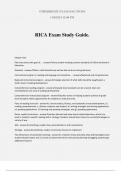©THEBRIGHT EXAM SOLUTIONS
11/8/2024 12:08 PM
RICA Exam Study Guide.
Chapter One
Plan instruction with goal of... - answer✔every student meeting content standards of California Board of
Education.
Standard - answer✔What a child should know and be able to do at each grade level.
Instructional program in reading and language arts should be... - answer✔balanced and comprehensive
Balanced instructional program - answer✔strategic selection of what skills should be taught given a
child's level of reading development.
Comprehensive reading program - answer✔all grade level standards can be covered. Does not
overemphasize one area of reading development.
Comprehensive instructional program - answer✔teacher works on helping students achieve all grade
level standards. Many opportunities for students to read and write.
Parts of reading instructin - answer✔a.) word analysis, fluency, and systematic vocab development, b.)
reading comprehension, c.) literary response and analysis, d.) writing strategies and writing applications,
e.) speaking applications, f.) listening and speaking strategies, and g.) speaking applications.
Direct, explicit instruction - answer✔teacher-directed and have clearly stated objectives, which is to
teach a student a specific reading skill or strategy. Students should ahve chance to use skills/strategies in
variety of way
Skill - answer✔something a reader does automatically or with automaticity
Strategy - answer✔something a reader consciously chooses to implement
Two dimensions of systematic teaching - answer✔1.) teacher knows precisely what skills/strategies each
student should master and 2.) results of assessment drive instructional planning (struggling students get
additional lessons)
, ©THEBRIGHT EXAM SOLUTIONS
11/8/2024 12:08 PM
Goals of systematic teaching - answer✔to prevent reading difficulties in lower/younger grades.
Prevention of remediation.
Early intervention programs - answer✔focus on youngest readers who are having difficulties at the
earliest possible opportunity.
Differentiated Instruction - answer✔meet individual differences. struggling students, ELLs, and advanced
students. Small group lessons. Different strategies for different groups of students. Different resources
and materials for different groups of students.
Long-term Goals - answer✔For school year. Organized for each month. Teacher plans time to cover all
standards. Goal achieved through several lessons with small number of learning objectives.
Short-tern goals - answer✔Brief period. Week or two. Ex: have students compare and contrast elements
of two or more stories. Teachers must use evidence to prove learning objectives met. Paper/Pen and
observations acceptable evidence.
Key factors in differentiated reading instruction - answer✔consider: students' knowledge and skills,
prerequisite knowledge and skills, pacing of instruction, complexity of skills/content to be presented,
and scaffolds.
Flexible grouping - answer✔groups formed to teach one skill and then disbanded once particular goal is
met.
Homogeneous grouping - answer✔Children in group have same ability
Basal reading programs - answer✔CA state board of education (SBE) reading, ELA program. Feature
teacher's manual, student text (basal reader), student workbooks, supplemental books, CDs with
additional resources, and assessment resources. Must have programs for struggling readers, advanced
readers, and ELLs.
Benchmark, strategic, and intensive groups - answer✔benchmark = small difficulty; strategic = 1 or 2
years behind. special lessons required for students; intensive groups = more than two years behind.
special resources. highest level of differentiation. slower paced lessons. more manageable chunks of
instruction.
Components of effective instructional delivery - answer✔orientation, presentation, structured and
guided practices, and independent practice and application.
Book clubs - answer✔small, formal groups of students assigned by teacher who read same book.
Students meet while reading and immediately after reading. Teacher helps starts discussion, but
students should do most of it. Can give roles to students (moderator, vocab, etc.)
Literature circles - answer✔small group discussion. Students select what they read and all read same
book.
, ©THEBRIGHT EXAM SOLUTIONS
11/8/2024 12:08 PM
Author studies - answer✔teacher assigns group of students to read books or works by author of
children's literature. Read more than one work by author. Students present talks on author and works as
a group.
Promoting and monitoring independent reading - answer✔Should be self selected and self
monitored/paced. Tell children to pick books at their reading level (not too easy or too hard - Goldilocks)
5 words too hard on a page, too difficult.
Interest inventories - answer✔Students more likely to read if they have texts they like. Used to
determine students interests and how much the child enjoys reading. Interpret results to suggest books
to students.
I + I Strategy - answer✔independent reading level + personal interest = best chance of success
Independent reading opportunities in class - answer✔SSR (sustained silent reading); Readers' Workshop,
at home reading (hold students and parents accountable)
Methods for monitoring student independent reading - answer✔student-maintained reading logs, books
reports, formal and informal oral presentations, individual conferences.
Promoting skillful teaching of reading - answer✔reading coaches/literary coaches, grade-level meetings,
professional development
Chapter Two - answer✔Chapter Two
Primary purposes of reading assessments - answer✔entry-level, monitoring of progress, and summative
assessments
Entry-level assessments - answer✔implemented prior to instruction to determine students' prerequisite
skills and knowledge.
Progress-monitoring assessments - answer✔take place during instruction unit. tell teacher what
students are making adequate, advanced, or slow progress.
Summative Assessments - answer✔determine if students have met standard. Can be given to measure
achievement of single or a group of standards.
Alternative Assessments for IEPs/504s - answer✔Give students more time, divide assessment into
smaller units, change the mode of delivery, provide practice assessments, prove simpler version of the
assessment.
Standardized test - answer✔has established, consistent testing procedure. Have manual/script for test
administrator. Strict instructions and time limits.
Reliability - answer✔test has this is results yield consistent scores across administrations.
Validity - answer✔test is this if it measures what it claims to measure.




